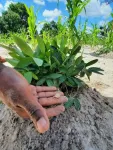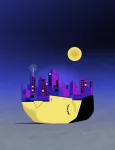(Press-News.org) It may be possible to create paved roads and landing pads on the Moon by using lasers to melt lunar soil into a more solid, layered substance, reports a proof-of-concept study in Scientific Reports. Although these experiments were carried out on Earth using a substitute for lunar dust, these findings demonstrate the viability of the technique and suggest it could be replicated on the Moon. However, further work may be needed to refine the process, according to the authors.
Moon dust poses a significant challenge to lunar rovers as, due to the low levels of gravity, it tends to float around when disturbed and can damage equipment. Therefore, the infrastructure such as roads and landing pads will be essential to mitigate dust issues and facilitate transport on the Moon. However, transporting materials for construction from Earth is costly, so it will be essential to use the resources available on the Moon.
Ginés-Palomares, Miranda Fateri, and Jens Günster melted a fine-grained material called EAC-1A (developed by ESA as a substitute for lunar soil) with a carbon dioxide laser to simulate how lunar dust can be melted by focused solar radiation on the Moon into a solid substance. The authors experimented with laser beams of different strengths and sizes (up to 12 kilowatts and 100 milimetres across respectively) in order to create a robust material, although they established that criss-crossing or overlapping the laser beam path led to cracking. They developed a strategy using a 45 millimetre diameter laser beam to produce triangular, hollow-centred geometric shapes approximately 250 millimetres in size. These could be interlocked to create solid surface across large areas of lunar soil which could serve as roads and landing pads, suggest the authors.
To reproduce this approach on the Moon, the authors calculate that a lens of approximately 2.37 metres squared would need to be transported from Earth to act as a sunlight concentrator in place of the laser. The relatively small size of equipment needed would be an advantage in future Moon missions.
END
Astronomy: One small step towards lunar roads
2023-10-12
ELSE PRESS RELEASES FROM THIS DATE:
AI just got 100-fold more energy efficient
2023-10-12
AI is so energy hungry that most data analysis must be performed in the cloud
New energy-efficient device enables AI tasks to be performed within wearables
This allows real-time analysis and diagnostics for faster medical interventions
Researchers tested the device by classifying 10,000 electrocardiogram samples
The device successfully identified six types of heart beats with 95% accuracy
EVANSTON, Ill. — Forget the cloud.
Northwestern University engineers have developed a new nanoelectronic device that can perform accurate machine-learning classification tasks in the most energy-efficient ...
Around the globe, climate adaptation lacks coordination
2023-10-12
Viewed globally, it is above all individuals and households that are pursuing adaptation to the impacts of climate change; systematic networking of the various groups affected is lacking. This is the conclusion reached by an international team of experts from Universität Hamburg’s Cluster of Excellence for climate research (CLICCS) and Ludwig-Maximilians-Universität München (LMU). Their meta-study was just released in the journal Nature Climate Change.
For their meta-study, the 30 authors analyzed more than 1,400 academic studies on climate change adaptation. By doing so, they offer the first global overview of which groups of actors are pursuing adaptation – and ...
Red blood cell transfusion in the ICU
2023-10-12
About The Study: Red blood cell (RBC) transfusion was common in patients admitted to 233 intensive care units in 30 countries between 2019 and 2022, with high variability across centers in transfusion practices. Although many different clinical reasons and triggers were stated for RBC transfusion, the three most common reasons (low hemoglobin level, active bleeding, hemodynamic instability) and triggers (hypotension, tachycardia, no physiological trigger affected the decision to transfuse) were largely overlapping in all regions.
Authors: Alexander P. J. Vlaar, M.D., Ph.D., M.B.A., of Amsterdam University Medical ...
Small-volume blood collection tubes to reduce transfusions in intensive care
2023-10-12
About The Study: This randomized trial in 25 adult medical-surgical intensive care units (ICUs) in Canada found that the transition from standard-volume to small-volume tubes for blood collection in the ICU may reduce red blood cell transfusion without impacting biospecimen sufficiency for laboratory analysis.
Authors: Deborah M. Siegal, M.D., M.Sc., of McMaster University in Hamilton, Ontario, Canada, is the corresponding author.
To access the embargoed study: Visit our For The Media website at this link https://media.jamanetwork.com/
(doi:10.1001/jama.2023.20820)
Editor’s Note: Please see the article for ...
The burden of lung cancer in women compared with men in the US
2023-10-12
About The Study: Based on high-quality population-based data, this study found that the higher lung cancer incidence in women than in men has not only continued in individuals younger than 50 years but also now extends to middle-aged adults as younger women with a high risk of the disease enter older age. Reasons for this shift are unclear because the prevalence and intensity of smoking are not higher in younger women compared with men except for a slightly elevated prevalence among those born in the 1960s.
Authors: Ahmedin Jemal, D.V.M., Ph.D., of the American Cancer Society in Atlanta, is the corresponding author.
To access the embargoed study: ...
Race and ethnicity and primary language in emergency department triage
2023-10-12
About The Study: In this study of 249,000 visits to seven academic and community hospital emergency departments, patients who identified as Black, Hispanic, and Other race and ethnicity were assigned less acute Emergency Severity Index scores than their white peers despite having received more involved physician workups, suggesting some degree of mistriage. Clinical decision support systems might reduce these disparities but would require careful calibration to avoid replicating bias.
Authors: Joshua W. Joseph, M.D., M.S., ...
Big blood savings: large trial in JAMA shows taking less blood for lab testing reduces transfusions in intensive care
2023-10-12
A world-first clinical trial published in JAMA could provide an easy way to save tens of thousands of units of blood every year in Canada and much more worldwide. The trial, which involved more than 27,000 patients in 25 adult intensive care units (ICUs) across Canada, showed that taking less blood for lab tests using “small-volume” tubes reduced the need for almost one blood transfusion for every 10 patients.
Most hospitals use standard tubes that automatically draw four to six milliliters (ml) of blood, but a typical laboratory test requires less than 0.5 ml of blood, meaning the rest (more ...
We can respond to verbal stimuli while sleeping
2023-10-12
Sleep is generally defined as a period during which the body and mind are at rest—as if disconnected from the world. However, a new study led by Delphine Oudiette, Isabelle Arnulf, and Lionel Naccache at Paris Brain Institute shows that the frontier between wakefulness and sleep is much more porous than it seems.
The researchers have shown that ordinary sleepers can pick up verbal information transmitted by a human voice and respond to it by contracting their facial muscles. This astonishing ability occurs intermittently during almost all stages of sleep—like windows of connection with the outside world were temporarily opened on this occasion.
These new findings ...
Flagship individuals can boost conservation
2023-10-12
“Flagship” individual animals like Cecil the lion or Freya the walrus can boost conservation, new research suggests.
Much-loved species like pandas and polar bears are widely used in conservation campaigns.
However, a new study argues that individual animals or plants can also be used as flagships, with enormous potential to raise awareness and mobilise public support.
The recent outcry over the felling of the “Sycamore Gap” tree in the UK demonstrates the power of individual plants or animals in public opinion.
“Flagship individuals typically share some common characteristics,” ...
Letting go of an extra weight to control sleeping sickness
2023-10-12
Letting go of an extra weight to control sleeping sickness
A new study led by Luísa Figueiredo, group leader at the Instituto de Medicina Molecular João Lobo Antunes (iMM; Portugal), and published today in the scientific journal Nature Microbiology* found a new strategy by the host to cope with Trypanosoma brucei infection. Trypanosoma brucei is the parasite that causes sleeping sickness in humans, and nagana in cattle, which remain a public health ...




